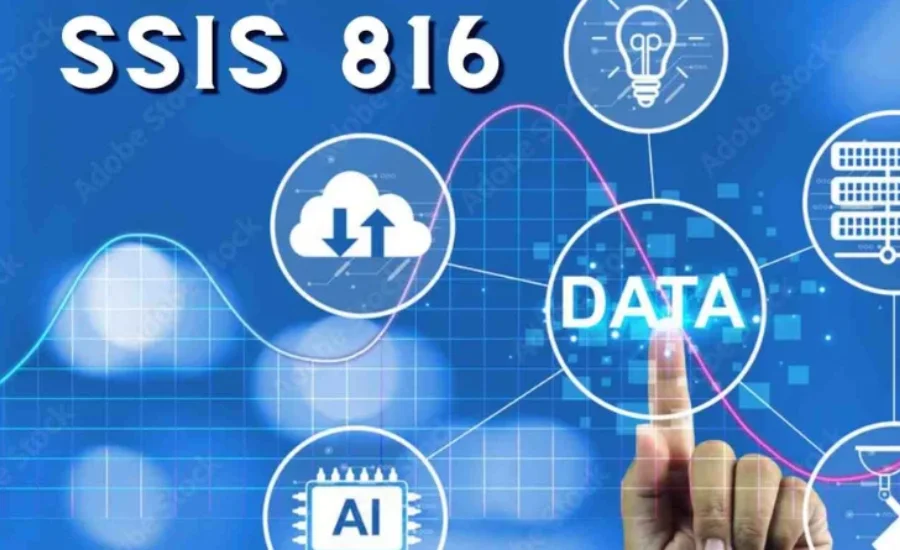Business
Exploring SSIS816: The Future of Data Integration and Management
Published
1 year agoon
By
James flick
In today’s data-driven world, businesses are increasingly relying on sophisticated tools to manage, integrate, and analyze large volumes of data. One such powerful tool that has garnered significant attention is SSIS816, a robust data integration platform designed to streamline the process of extracting, transforming, and loading (ETL) data from various sources. As organizations seek to enhance their data management capabilities, SSIS816 has emerged as a game-changer, offering a comprehensive suite of features that cater to the diverse needs of modern enterprises. This article delves into the world of SSIS816, exploring its functionalities, benefits, and why it is considered the future of data integration and management.
Understanding SSIS816: What Is It and How Does It Work?

SSIS816, or SQL Server Integration Services 816, is a platform that provides data integration and workflow automation solutions for enterprises. It is part of the SQL Server suite and is designed to handle complex data integration tasks efficiently. At its core, SSIS816 allows users to create and manage data workflows that can extract data from various sources, transform it according to business requirements, and load it into a destination, such as a data warehouse or database. The platform supports a wide range of data formats and sources, including relational databases, flat files, XML, and more. By automating the ETL process, SSIS816 helps businesses improve data accuracy, reduce manual errors, and increase operational efficiency.
Key Features of SSIS816: Enhancing Data Integration
SSIS816 is equipped with a host of features that make it an indispensable tool for data integration. One of its standout features is the intuitive graphical user interface (GUI), which allows users to design data workflows without the need for extensive coding knowledge. The drag-and-drop interface makes it easy to create complex workflows, enabling users to focus on the logic of data transformation rather than the technical details. Additionally, SSIS816 supports data transformation through a variety of built-in tasks and components, such as data cleaning, aggregation, sorting, and more. These features allow businesses to tailor their data integration processes to meet specific needs, ensuring that the final data output is accurate and relevant.
Why SSIS816 is Essential for Modern Enterprises
In the era of big data, the ability to integrate and manage data from multiple sources is crucial for business success. SSIS816 offers a scalable and flexible solution that can handle large volumes of data with ease. Whether it’s integrating data from cloud-based platforms, on-premises databases, or third-party applications, SSIS816 provides a unified approach to data management. This capability is particularly important for organizations that operate in dynamic environments, where data sources and formats can change frequently. With SSIS816, businesses can adapt to these changes quickly, ensuring that their data integration processes remain efficient and effective.
Automation and Efficiency: The Power of SSIS816
One of the primary advantages of SSIS816 is its ability to automate repetitive and time-consuming tasks, freeing up valuable resources for more strategic activities. The platform’s automation capabilities extend beyond the ETL process, allowing users to schedule workflows, monitor their execution, and receive notifications in case of errors or failures. This level of automation not only increases operational efficiency but also reduces the risk of human error, which can have significant consequences in data-driven decision-making. Furthermore, SSIS816 integrates seamlessly with other tools in the SQL Server suite, such as SQL Server Agent, to provide a comprehensive solution for managing data workflows and ensuring data quality.
Customizing Data Workflows with SSIS816
SSIS816 offers a high degree of customization, allowing businesses to design data workflows that align with their specific needs. The platform supports custom scripting through integration with languages like C# and VB.NET, giving users the flexibility to create bespoke data transformations and business logic. This feature is particularly useful for organizations with unique data processing requirements that cannot be addressed by the standard components available in SSIS816. Additionally, the platform’s extensibility allows for the integration of third-party components, further enhancing its functionality and enabling businesses to leverage additional tools and technologies within their data workflows.
Security and Compliance: SSIS816’s Robust Framework
In an age where data security and compliance are paramount, SSIS816 provides a robust framework to ensure that data is handled securely throughout the integration process. The platform supports encryption, data masking, and other security features that protect sensitive information from unauthorized access. Additionally, SSIS816 includes features that help organizations comply with industry regulations, such as GDPR and HIPAA, by enabling secure data transfer and storage. These security measures are crucial for businesses that deal with confidential or sensitive data, as they help mitigate risks and ensure that data is handled in accordance with legal and regulatory requirements.
Scalability and Performance: Handling Big Data with SSIS816
As businesses grow, so too does the volume of data they must manage. SSIS816 is designed to scale with the needs of the organization, handling large datasets without compromising performance. The platform’s architecture supports parallel processing, which allows multiple data workflows to be executed simultaneously, significantly reducing processing time. This scalability is particularly beneficial for enterprises that deal with big data, as it ensures that data integration processes can keep pace with the increasing volume and complexity of data. Additionally, SSIS816’s performance tuning features allow users to optimize their workflows, ensuring that data is processed efficiently and without bottlenecks.
Integration with Cloud Services: Expanding SSIS816’s Capabilities
With the growing adoption of cloud computing, SSIS816 has evolved to support seamless integration with various cloud services, including Azure, AWS, and Google Cloud. This integration allows businesses to extend their data workflows beyond on-premises environments, enabling them to leverage the scalability, flexibility, and cost-effectiveness of the cloud. SSIS816’s cloud integration capabilities include support for cloud-based data sources, data storage solutions, and cloud-based processing engines. This flexibility is essential for modern enterprises that operate in hybrid or multi-cloud environments, as it allows them to create data workflows that span across different platforms and environments.
Real-World Applications of SSIS816
SSIS816 is used across a wide range of industries and applications, from financial services and healthcare to retail and manufacturing. In the financial sector, for example, SSIS816 is used to integrate data from various sources, such as trading platforms, customer databases, and regulatory systems, to create a unified view of the business. In healthcare, SSIS816 enables the integration of patient data from multiple systems, facilitating better patient care and improving operational efficiency. In retail, SSIS816 supports the integration of sales, inventory, and customer data, enabling businesses to gain insights into consumer behavior and optimize their operations accordingly. These real-world applications demonstrate the versatility and effectiveness of SSIS816 in addressing the data integration needs of diverse industries.
Training and Support: Getting the Most Out of SSIS816
For organizations looking to implement SSIS816, training and support are crucial to ensuring a smooth transition and successful deployment. Microsoft offers a range of resources, including documentation, tutorials, and certification programs, to help users get up to speed with SSIS816. Additionally, a vibrant community of users and experts provides forums, blogs, and other resources where users can share knowledge and troubleshoot issues. Investing in training and support ensures that users can fully leverage the capabilities of SSIS816, maximizing its value and effectiveness within the organization.
Future Trends: What’s Next for SSIS816?
As the world of data integration continues to evolve, SSIS816 is expected to keep pace with emerging trends and technologies. One area of development is the integration of artificial intelligence and machine learning capabilities into the platform, enabling more advanced data processing and analysis. Additionally, SSIS816 is likely to see further enhancements in its cloud integration features, as more businesses move their data and applications to the cloud. The ongoing development of SSIS816 will ensure that it remains a leading solution for data integration, helping businesses navigate the complexities of modern data management and stay competitive in an increasingly data-driven world.
FAQs about SSIS816
1. What is SSIS816?
SSIS816, or SQL Server Integration Services 816, is a data integration platform that allows businesses to automate the process of extracting, transforming, and loading (ETL) data from various sources.
2. How does SSIS816 benefit my business?
SSIS816 helps businesses streamline data integration processes, reduce manual errors, improve data accuracy, and increase operational efficiency through automation and customization.
3. Can SSIS816 handle big data?
Yes, SSIS816 is designed to scale with your business needs and can handle large volumes of data efficiently, making it suitable for big data applications.
4. Is SSIS816 secure?
SSIS816 includes robust security features such as encryption and data masking, ensuring that sensitive information is handled securely and in compliance with industry regulations.
5. Can SSIS816 integrate with cloud services?
Yes, SSIS816 supports seamless integration with various cloud services, including Azure, AWS, and Google Cloud, enabling businesses to extend their data workflows to the cloud.
Conclusion
SSIS816 stands as a powerful tool for modern data integration, offering a comprehensive suite of features that address the diverse needs of businesses in today’s data-driven landscape. From its robust automation capabilities to its scalability and security features, SSIS816 is designed to help organizations manage their data more effectively and efficiently. Whether you are dealing with big data, cloud integration, or complex data workflows, SSIS816 provides the tools and flexibility needed to stay ahead in a competitive environment. As businesses continue to embrace digital transformation, SSIS816 will undoubtedly play a pivotal role in shaping the future of data management and integration.
